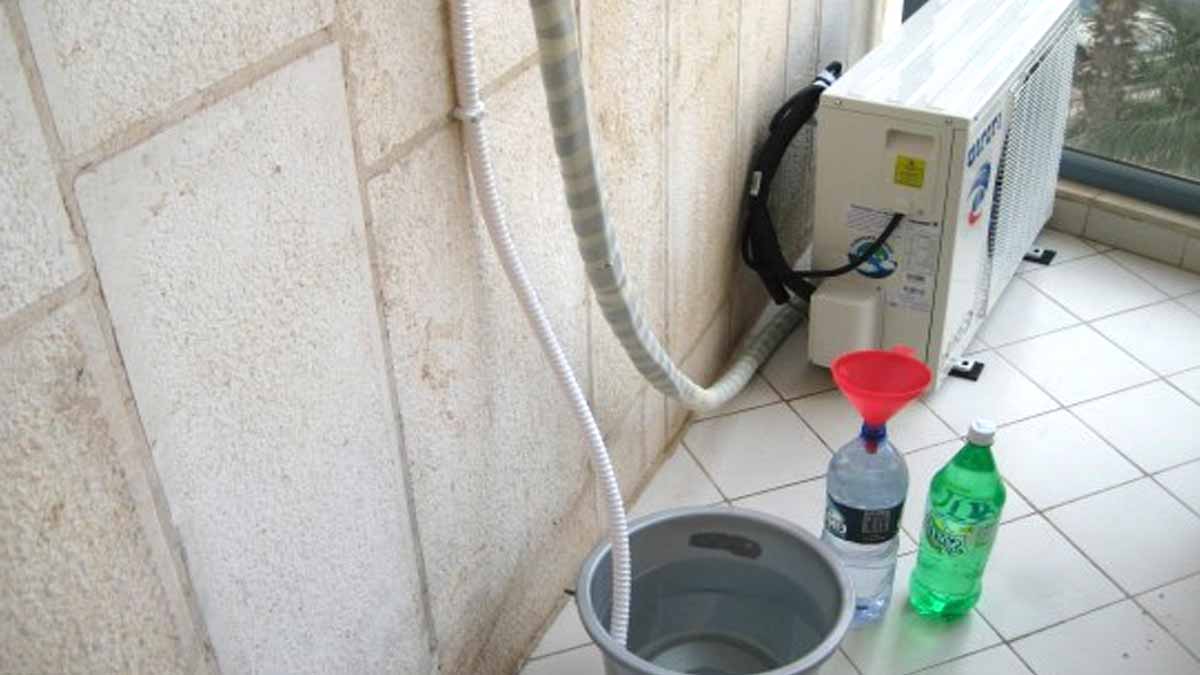The quiet drip from air conditioners hides a practical secret. That clear condensate is naturally low in minerals, so it behaves like distilled water and leaves no chalky trace. Used wisely, it lightens cleaning, protects appliances, and helps plants when handled with care. It is not drinking water, because ducts and drains may host microbes, yet it becomes a smart household ally once you collect it cleanly and store it well.
Understanding the source and its limits
Condensate forms as warm indoor air meets cold evaporator coils; humidity turns to droplets, then flows to a drain. This process strips dissolved salts, so the water comes out soft, nearly demineralized. It resembles store-bought distilled water, yet arrives free at home while your system runs in hot, humid weather.
Purity does not mean potability, because biofilms can grow inside pans, hoses, and trays. That risk rules out drinking uses, though cleaning tasks love the mineral-free profile. Good hygiene still matters, since dirty containers seed bacteria. A clean bottle, washed often with soap, keeps quality steady for non-food purposes.
Collection stays simple, so the barrier to entry is low. Place a disinfected bucket under the outlet, then cap the container between uses. People who run cooling daily may add a small tank for convenience, because output scales with humidity, unit size, and runtime. In peak months, several gallons can drip away if you do nothing.
Spotless results on glass, mirrors, and cars with air conditioners water
Streaks vanish when minerals are not there to dry on the surface, so windows and mirrors shine faster. Spray, wipe with microfiber, then buff lightly; the finish dries clear because no calcium stays behind. Indoors, fridge doors, induction glass, and chrome taps keep their glow longer between sessions.
Car lovers keep a separate jug for the final rinse, and the payoff is obvious on dark paint. Use tap water for the wash, then switch for the last sheet of water, because spots form when minerals cure on warm panels. This swap saves time later, as you skip a second polish pass.
Steam tools also prefer soft water, since scale clogs narrow jets. Fill handheld steamers with condensate to protect pumps, so pressure stays stable and performance lasts. Cleaning concentrates often work better when minerals stop interfering with surfactants. That small change boosts degreasing power while it also prevents crust inside spray nozzles.
Protecting irons, humidifiers, and kettles
Steam irons live longer when scale never starts. Condensate controls limescale in the reservoir and keeps vents open, so steam remains even and fabrics stay free of white specks. Because residue cannot bake into soleplates, gliding feels smoother, and bursts remain strong across long sessions.
Room humidifiers behave kindly with mineral-free fills. White “dust” on shelves comes from hard water, so removing minerals solves that mess at the source. Tanks stay cleaner, and wicks avoid crust, because magnesium and calcium do not crystallize there. Filters last longer, so the device runs quietly at steady output.
Kettles and coffee makers also benefit, since scale lines the heating element and slows boiling. Taste can change with mineral profiles, so use condensate for maintenance cycles or alternate fills. That way, you reduce descaling jobs, because the system builds less stone day after day. The routine saves parts, energy, and time from needless scrubbing of air conditioners byproducts.
Smarter plant care without starving roots
Plants like chlorine-free water, and condensate arrives gentle. Short-term watering is fine because leaves avoid chemical stress, while soil structure stays stable. Yet pure water carries almost no nutrients, so roots cannot sip calcium or traces they need unless you supply them from soil or fertilizer.
Balance solves it. Mix with regular tap water or add a mild, complete feed, and growth keeps pace. Sensitive species—carnivorous plants, many orchids, and some tropicals—prefer low-mineral inputs, so this resource fits them well. They suffer when salts build up, while soft watering protects their delicate root hairs.
Certain tasks love the purity regardless of species. Use it for seed germination trays to prevent crust on tiny roots, so seedlings emerge evenly. Fine misters stay unclogged, since no grit forms in the nozzles. Hydroponic growers set nutrients precisely, because the base water is blank; measurements stay true with air conditioners condensate.
Safe storage, simple systems, and daily habits with air conditioners water
A routine keeps quality high. Label your container, rinse it often, and let it air-dry covered, because sealed damp spaces breed microbes. If the water smells musty, discard it. That quick check protects surfaces, tools, and plants, while the supply remains ready for your next task.
Small upgrades make collection hands-off. A short hose to a lidded can reduces splashing, and a mesh screen blocks debris. People who cool all day can add a larger tank with a spigot, so decanting is clean. The path stays short from drain to storage, and contamination risk stays low.
Household rhythm improves when each use has its spot. Keep a jug near the laundry for irons, another by the garage for final rinses, and a sprayer under the sink for windows. Because habits beat intentions, access removes friction. The same supply supports indoor leaves, while your stainless steel keeps that showroom sheen.
A final word before you pour
Let the drip work for you, because free, low-mineral water is too useful to waste. Treat it as non-potable, yet ideal for cleaning, appliance care, and targeted plant tasks. With clean containers and simple routines, air conditioners turn a by-product into everyday value without effort or expense.
